Papers by Steve Whittaker
Background Our emotions and memories are intertwined, each influencing the other. For example, au... more Background Our emotions and memories are intertwined, each influencing the other. For example, autobiographical memory, the personal memories from our lifetime, plays a critical role in enhancing positivity (Conway and Pleydell-Pearce 2000). In turn, our current mood shapes memories by filtering what we remember (Berntsen 2002; Matt et al. 1992). Mood-congruent memory, for instance biases us to remember past experiences that are emotionally consistent with current mood. However, in other contexts, people
Proceedings of the 33rd Annual ACM Conference on Human Factors in Computing Systems - CHI '15, 2015
Proceedings of the SIGCHI Conference on Human Factors in Computing Systems - CHI '13, 2013
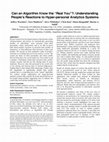
Recent research has developed analytics that threaten online self-presentation and privacy by aut... more Recent research has developed analytics that threaten online self-presentation and privacy by automatically generating profiles of individuals' most personal traits-their personality, values, motivations, and so on. But we know little about people's reactions to personal traits profiles of themselves, or what influences their decisions to share such profiles. We present an early qualitative study of people's reactions to a working hyper-personal analytics system. The system lets them see their personality and values profile derived from their own social media text. Our results reveal a paradox. Participants found their personal traits profiles creepily accurate and did not like sharing them in many situations. However, they felt pressured by the social risks of not sharing and showed signs of learned helplessness, leading them to share despite their misgivings. Further, they felt unqualified to significantly modify their profile contents due to a surprising trust in the "expert" algorithm. We explore design implications for hyper-personal analytics systems that consider the needs and preferences of the people being profiled, suggesting ways to enhance the control they feel and the benefits they reap.
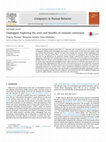
Computer-mediated-communication (CMC) is a ubiquitous part of people's lives, yet little research... more Computer-mediated-communication (CMC) is a ubiquitous part of people's lives, yet little research has investigated attitudes about unplugging, also known as media refusal. In this large-scale lifespan study we surveyed 446 participants ages 14e79 about their feelings and attitudes toward unplugging from CMC for 24 h. We also probed their actual recent experiences of unplugging. We were particularly interested in age differences. As predicted, younger people reported more negative feelings about unplugging, and people who reported higher scores on a loneliness survey also expressed more negative feelings. However, contrary to our hypothesis, there were no significant age differences in the length of time participants typically spent unplugged. Open-ended responses revealed that participants felt a mix of emotions about unplugging from CMC and were ambivalent about its use for connection; "connecting with family and friends" was listed as both a loss and a gain of unplugging. In addition, prior experience unplugging predicted less anxiety about a future anticipated unplugging experience. We discuss agerelated themes that emerged about costs and benefits to unplugging, anticipated unplugging activities, reasons for unplugging, and the inherent complexity of retreating from the web of digital technology and its pull of readily available community, connection, and information.
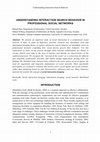
We present an empirical study of social interaction in a professional social network. It takes as... more We present an empirical study of social interaction in a professional social network. It takes as point of departure, previous research into distributed work and information foraging theory to explore interaction search behavior of individuals active in professional networks examining how social factors govern their behavior. For this exploration we focus on the process through which relevant collaborators are chosen to execute shared work tasks in the area of logistics and identify six characteristics of the explored processes. We recognize the "survival of the social" as a cornerstone for efficient and long-term professional networks and outline design implications arising from our findings. We identified some characteristics related to the active nature of social agents, the need for negotiation and long-term maintenance of social networks. More specifically participants are oriented to solutions that involve active social agents and social relations, rather than optimizing based on task characteristics, efficiency and cost. These behaviors motivate the need for the concept of social interaction foraging.
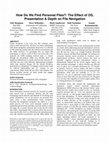
Folder navigation is the main way that computer users retrieve their personal files. However we k... more Folder navigation is the main way that computer users retrieve their personal files. However we know surprisingly little about navigation, particularly about how it is affected by the operating system used, the interface presentation and the folder structure. To investigate this, we asked 289 participants to retrieve 1,109 of their own active files. We analyzed the 4,948 resulting retrieval steps, i.e. moves through the hierarchical folder tree. Results show: (a) significant differences in overall retrieval time between PC and Mac that arise from different organizational strategies rather than interface design; (b) the default Windows presentation is suboptimalif changed, retrieval time could be reduced substantially and (c) contrary to our expectations, folder depth did not affect step duration. We discuss possible reasons for these results and suggest directions for future research.
ii Background The goal of this workshop is to provide a follow-on forum to last year's very succe... more ii Background The goal of this workshop is to provide a follow-on forum to last year's very successful Argumentation Mining workshop at ACL, the first research forum devoted to argumentation mining in all domains of discourse.
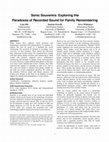
Many studies have explored social processes and technologies associated with sharing photos. In c... more Many studies have explored social processes and technologies associated with sharing photos. In contrast, we explore the role of sound as a medium for social reminiscing. We involved 10 families in recording 'sonic souvenirs' of their holidays. They shared and discussed their collections on their return. We compared these sounds with their photo taking activities and reminiscences. Both sounds and pictures triggered active collaborative reminiscing, and attempts to capture iconic representations of events. However sounds differed from photos in that they were more varied, familial and creative. Further, they often expressed the negative or mundane in order to be 'true to life', and were harder to interpret than photos. Finally we saw little use of pure explanatory narrative. We reflect on the relations between sound and family memory and propose new designs on the basis of our findings, to better support the sharing and manipulation of social sounds.
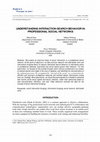
We present an empirical study of social interaction in a professional social network. As the poin... more We present an empirical study of social interaction in a professional social network. As the point of departure, we take previous research into distributed work and information foraging theory to explore interaction search behavior of individuals active in professional networks, examining how social factors govern their behavior. For this exploration, we focused on the process through which relevant collaborators are chosen to execute shared work tasks in the area of logistics, and identified six characteristics of efficient and long-term professional networks and outlined design implications arising from our findings. More specifically, we found that participants are oriented to solutions that involve active social agents and social relations, rather than optimizing based on task characteristics, efficiency, and cost. These behaviors motivate the need for the concept of social interaction foraging.
People who are collaborating can share files in two main ways:
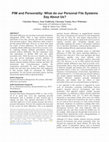
Individual differences are prevalent in personal information management (PIM). There is large var... more Individual differences are prevalent in personal information management (PIM). There is large variation between individuals in how they structure and retrieve information from personal archives. These differences make it hard to develop general PIM tools. However we know little about the origins of these differences. We present two studies evaluating whether differences arise from personality traits, by exploring whether different personalities structure personal archives differently. The first exploratory study asks participants to identify PIM cues that signal personality traits. While the aim was to identify cues, these cues also proved surprisingly accurate indicators of personality. In a second study, to evaluate these cues, we directly measure relations between structure and traits. We demonstrate that Conscientiousness predicts file organization, particularly PC users' desktops. Neurotic people may also keep more desktop files. One implication is that systems might be customized for different personalities. We also advance personality theory, showing that personal digital artifacts signal personality.

We carried out fieldwork to characterise and compare physical and digital mementos in the home. P... more We carried out fieldwork to characterise and compare physical and digital mementos in the home. Physical mementos are highly valued, heterogeneous and support different types of recollection. Contrary to expectations, we found physical mementos are not purely representational, and can involve appropriating common objects and more idiosyncratic forms. In contrast, digital mementos were initially perceived as less valuable, although participants later reconsidered this. Digital mementos were somewhat limited in function and expression -largely involving representational photos and videos, and infrequently accessed. We explain these digital limitations and conclude with design guidelines for digital mementos, including better techniques for accessing and integrating these into everyday life -allowing them to acquire the symbolic associations and lasting value that characterise their physical counterparts.
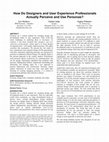
Personas are a critical method for orienting design and development teams to user experience. Pri... more Personas are a critical method for orienting design and development teams to user experience. Prior work has noted challenges in justifying them to developers. In contrast, it has been assumed that designers and user experience professionals-whose goal is to focus designs on targeted users-will readily exploit personas. This paper examines that assumption. We present the first study of how experienced user-centered design (UCD) practitioners with prior experience deploying personas, use and perceive personas in industrial software design. We identify limits to the persona approach in the context studied. Practitioners used personas almost exclusively for communication, but not for design. Participants identified four problems with personas, finding them abstract, impersonal, misleading and distracting. Our findings argue for a new approach to persona deployment and construction. Personas cannot replace immersion in actual user data. And rather than focusing on creating engaging personas, it is critical to avoid persona attributes that mislead or distract.
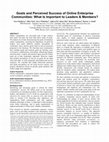
Online communities are successful only if they achieve their goals, but there has been little dir... more Online communities are successful only if they achieve their goals, but there has been little direct study of goals. We analyze novel data characterizing the goals of enterprise online communities, assessing the importance of goals for leaders, how goals influence member perceptions of community value, and how goals relate to success measures proposed in the literature. We find that most communities have multiple goals and common goals are learning, reuse of resources, collaboration, networking, influencing change, and innovation. Leaders and members agree that all of these goals are at least moderately important. However, leader and member perceptions of success on goals do not align with each other, or with commonly used behavioral success measures. We conclude that simple behavioral measures and leader perceptions are not good success metrics, and propose alternatives based on specific goals members and leaders judge most important.





Uploads
Papers by Steve Whittaker